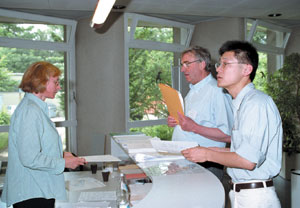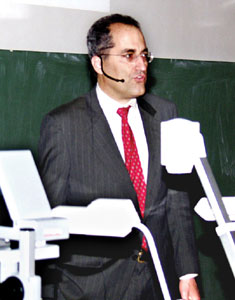Some 400 theorists and experimentalists gathered at DESY in June 2002 for the SUSY02 conference to discuss aspects of supersymmetry and the prospects for unification physics. Jan Louis and Peter Zerwas report the conference highlights.

The DESY laboratory in Hamburg, Germany, hosted the 10th International Conference on Supersymmetry and Unification of Fundamental Interactions (SUSY02) in June 2002, providing a forum for discussing the present status and future developments of supersymmetry (SUSY). In the week-long meeting – organized by Pran Nath of Northeastern University, US, and Peter Zerwas of DESY – theoretical ideas, analyses of experimental data, the expectations for physics at CERN’s Large Hadron Collider (LHC) and the proposed tera-electronvolt range electron-positron linear colliders were on the agenda.
A lively and exciting atmosphere prevailed, with established practitioners exchanging standard and not-so-standard views on the evolution of particle physics with enthusiastic youngsters. The excitement had its roots in the fascinating prospect of addressing fundamental problems of physics in the new generation of accelerators, and in the well-founded hope of hearing about long-awaited breakthroughs that would answer many of the outstanding questions.
Waiting for SUSY
On the experimental side, the conference marked the transition from the experiments completed at CERN’s LEP, DESY’s HERA, Fermilab’s Tevatron and SLAC’s SLC colliders, to those at Tevatron Run II and HERA-II and to preparations for physics at future collider facilities.
The experiments at LEP, reviewed by Eilam Gross of Israel’s Weizmann Institute, have covered a range of parameter space in the Higgs sector of the minimal supersymmetric extension of the Standard Model, which was summarized by Howard Haber of the University of California, Santa Cruz, US. The experiments seem to have ruled out one of the two parameter ranges singled out previously by theoretical arguments (the so-called small tanb region). However, the large tanb region was not fully covered by LEP and, as Fermilab’s Marcela Carena pointed out, it is of great interest for forthcoming Higgs searches at the Tevatron. On the other hand, Wolfgang Hollik of Karlsruhe offered strong support for a light Higgs boson as predicted by supersymmetric theories derived from the theoretical interpretation of precision data at LEP and the SLC.
Ritva Kinnunen of Helsinki, Finland, explained how LHC experiments will be able either to establish or rule out the existence of a light Higgs boson within a few years – in nearly all scenarios as pointed out by Jack Gunion of the University of California, Davis, US. Looking further ahead, CERN’s Marco Battaglia discussed how the profile of this fundamental particle could be studied experimentally at a linear collider with very high precision to establish the Higgs mechanism for generating the masses of standard particles.
Robert McPherson of Canada’s Victoria University reviewed the search for genuine supersymmetric particles at LEP. In its higher-energy phase, LEP set lower limits on the masses of the scalar partners of leptons close to the beam energy of 100 GeV. Similar limits have been achieved for the fermionic partners of W bosons, while the lightest supersymmetric particle has been constrained to a mass of more than 50 GeV, albeit in a model-dependent way. The masses of squarks and gluinos, on the other hand, have been increased by Tevatron analyses to more than 200 GeV, reported Teruki Kamon of Texas A&M University, US. This result is complemented by constraints on the stop mass in R-parity violating theories at HERA, discussed by Yves Sirois of the Ecole Polytechnique, France.

The discovery range for SUSY will be extended by the LHC to values of up to 3 TeV, leaving little room in parameter space for supersymmetric particles to hide, as analysed by Brookhaven’s Frank Paige. In the future, the properties of such particles could be measured to an accuracy of parts per million in the several hundred giga-electronvolt mass range by machines such as DESY’s proposed TESLA collider – presented by Hans-Ulrich Martyn of Aachen – reducing to the percentage level in the multitera-electronvolt range that could be explored by CERN’s CLIC. This allows the fundamental parameters in supersymmetric theories to be determined precisely, as Jan Kalinowski of Warsaw, Poland, concluded. Abdel Djouadi of Montpellier, France, Walter Majerotto of Vienna, Austria, and Michael Spira of the Paul Scherrer Institute, Switzerland, described the high-precision theoretical calculations (sometimes to two-loop accuracy) that underpin all of these results and expectations.
More information on supersymmetric scenarios, including the CP-violating sector, examined by Nath, is offered by precision measurements at lower energies. B-decays are affected by supersymmetric particles through virtual-loop effects. Antonio Masiero of Padova, Italy, pointed out that the agreement between present observations and the Standard Model is not at odds with the potential intervention of supersymmetric particles, while Matthias Neubert of Cornell, US, discussed the consequences of rare decays. Errors are still too large to draw definite conclusions in multidimensional SUSY parameter space on flavour physics.
Richard Arnowitt of Texas A&M showed how the discrepancy between the anomalous muon magnetic moment measurement and the predictions of the Standard Model is compatible with wide areas of supersymmetric parameter space. New insight – as presented by Isabella Masina of Saclay, France – might soon be obtained from studying lepton-flavour-violating processes, such as radiative muon decays into electrons. CERN’s Concha Gonzales-Garcia and Rabindra Mohapatra of Maryland, US, discussed the recent observation of neutrino oscillations that has prompted new interest in the search for such phenomena in the charged-lepton sector, with novel conversion processes enhanced by virtual SUSY contributions.
Giving mass and energy to the universe

It has long been speculated that the observation of cold dark matter in the universe is related to SUSY. If, as in many scenarios, the lightest supersymmetric particle is stable, it would be a perfect candidate for this new kind of matter. The signals of such particles, accounting for most of the mass of the universe, may be identified in dedicated searches or astrophysics experiments, as described by Keith Olive of Minnesota, US.
Cosmological problems are an excellent test ground for physics at very-high-energy scales. Baryogenesis – crucial for our own existence – can be explained by SUSY mechanisms if stop and Higgs masses are tightly constrained to barely above the present experimental exclusion limits, claimed Carlos Wagner of Argonne National Laboratory and Chicago University, US. A different picture emerges from leptogenesis, presented by Tsutomu Yanagida of Tokyo, Japan, where decays of heavy Majorana neutrinos with masses close to the grand unification scale are the source for the observed asymmetry of matter and antimatter in the universe.
Cosmological scenarios can cause problems for supersymmetric models. However, as Hans Peter Nilles of Bonn, Germany, explained, in detailed analyses these often appear less severe. Recent data on energy fluctuations in the cosmic microwave background and measurements of the deceleration parameter via the Hubble diagram of Type 1A supernovae suggest a positive cosmological constant. Pierre Binetruy of Orsay, France, emphasized that from a theoretical point of view, these results are more than puzzling, prompting the suggestion from Edward Copeland of Sussex University, UK, that brane-world models may offer alternative scenarios for the cosmology of the early universe.
Connecting to the Planck scale
The most compelling argument in support of the supersymmetric extension of the Standard Model is the unification of the three different gauge couplings – electromagnetic, weak and strong – at the percent level at a scale near 1016 GeV. After extrapolation over more than 14 orders of magnitude in energy, the three couplings meet in a tiny area with an accuracy that is much better than expected in many scenarios. This surprisingly successful prediction cannot be matched easily in alternative theories.
Although certain aspects of minimal versions are sometimes problematic, such as too-rapid proton decay, even conventional supersymmetric grand unified theories are still in agreement with data, said Stuart Raby of Ohio State University, US. Graham Ross of Oxford, UK, discussed the possible origin of quark and lepton mass textures in this context. Lawrence Hall of the University of California, Berkeley, US, and John March-Russell of CERN showed how higher dimensions offer additional freedom in building models, and thus are more flexible in removing the stumbling blocks of traditional grand unified theories. While Jon Bagger of Johns Hopkins University, US, discussed questions of SUSY breaking within such models, Edward Witten of Princeton, US, addressed how these models deal with the doublet-triplet splitting of the Higgs field. Riccardo Barbieri of the Scuola Normale Superiore in Pisa, Italy, covered aspects of electroweak symmetry breaking.
Peter Mayr of CERN showed how studying the phenomenological aspects of supersymmetric theories in string theory has been improved by extending the powerful techniques of mirror symmetry to theories with only N=1 SUSY. Furthermore, Jan de Boer of Amsterdam, the Netherlands, showed how string theory can also be exploited to shed new light on strongly coupled gauge theories, such as quantum chromodynamics, by means of the so-called AdS/CFT correspondence between string and field theory.
If SUSY is realized in nature, high-precision experiments at a linear collider such as TESLA followed by a second phase in a multitera-electronvolt collider such as CLIC, could determine the properties of new particles with very high precision. This is a necessary prerequisite for reconstructing the fundamental supersymmetric theory at the scale where SUSY breaking is localized, emphasized Gordon Kane of Michigan, US. If the SUSY parameters are transmitted at this scale from a hidden world to our visible eigen-world by gravitational interactions, these machines could be used as powerful telescopes to view a domain where particle physics and gravity are linked directly – a vision for the future.
A big step into the new experimental domain of high energy linked with high accuracy – successfully pioneered by LEP and the SLC – was outlined by DESY’s director-general, Albrecht Wagner, who presented the well-advanced plans for the TESLA machine, which has an energy target that is close to 1 TeV. If preparations continue as they are now, the particle physics community could be operating this unique tool for SUSY particle diagnostics by 2012.
Living in higher dimensions
The idea of the Standard Model being localized on a four-dimensional brane that is embedded in a higher dimensional space-time can be formulated in string theories. Ignatios Antoniadis of CERN, Mirjam Cvetic of Pennsylvania, US, and Luis Ibanez of Madrid’s Institute for Theoretical Physics, Spain, presented models where constructions of this type are carried out explicitly. Phenomenological aspects of extra dimensions on a tera-electronvolt scale are important for experiments at the next generation of particle accelerators. These were discussed by James Wells of the University of California, Davis, and Greg Landsberg of Brown University, US, who focused on the radiation of black holes from high-energy particle collisions.
It is likely that the structure of space-time is modified at ultrashort distances. An interesting aspect of this is the potential non-commutativity of space (and time). This would mean, for example, that measurements of the x and y co-ordinates of an event would affect each other in a similar way to the position and momentum measurements in standard quantum mechanics, albeit with the interference being characterized by a very-small-scale parameter. Volker Schomerus of Potsdam, Germany, showed that such an idea can be developed within string theory, while Julius Wess of Munich, Germany, developed similar ideas from a field-theoretical point of view.
The possibility that additional strongly coupled gauge groups on a tera-electronvolt energy scale could have a significant impact on the pattern of electroweak symmetry breaking and the Higgs sector was covered by Savas Dimopoulos of Stanford, US, Stefan Pokorski of Warsaw and Lisa Randall of Harvard, US. This possibility is also suggested by reducing elegant theoretical structures in higher dimensions to the standard 3+1 space-time dimensions.
The physics programme discussed at the conference focused on the innermost structures of the microcosm, for matter as well as space-time, but it found them deeply connected with the structure of the universe at large – the final step of ultimate unification.
Further information
The quest for unification

At SUSY02, DESY launched a series of annual lectures with the aim of conveying the fascination of particle physics to a wider audience at the university and in the city of Hamburg, Germany. Edward Witten of the Institute for Advanced Study at Princeton, US, presented the first DESY Heinrich Hertz Lecture on Physics.
DESY director-general, Albrecht Wagner, introduced the series with a description of Hertz’s great theoretical and experimental achievements. Born in 1857 in Hamburg, Hertz developed an outstanding talent for physics early in life. After becoming professor of physics at the Karlsruhe Polytechnicum in 1886, he carried out one of the most important experiments of the 19th century – demonstrating the existence of electromagnetic waves. This confirmed Maxwell’s theory, in which electricity and magnetism are unified to electromagnetism.

It was fitting, therefore, that Witten’s lecture covered the quest for unification. He described the steps and arguments leading us from the Standard Model of particle physics to grand unified theories at 1016 GeV. An extrapolation of precise experimental data on the three gauge couplings suggests that at this scale, weak and strong electromagnetic interactions merge to form a single unified interaction.
However, the evolution of the couplings of the individual interactions approach a single point accurately only if the Standard Model is extended to a supersymmetric theory. This may also open the door to unifying the genuine particle physics interactions with gravity. This last step may require the expansion of our four-dimensional space-time world to one of higher dimensions as required by superstring theories.
Forthcoming experiments at the LHC and future linear colliders will determine the truth of these ideas. Positive evidence would provide a more comprehensive picture of matter and forces in nature – the “ultimate unification” sought by the most eminent theorists in history.








